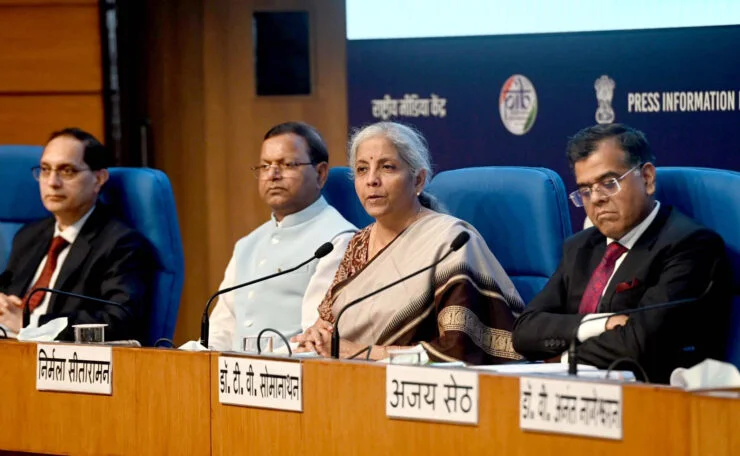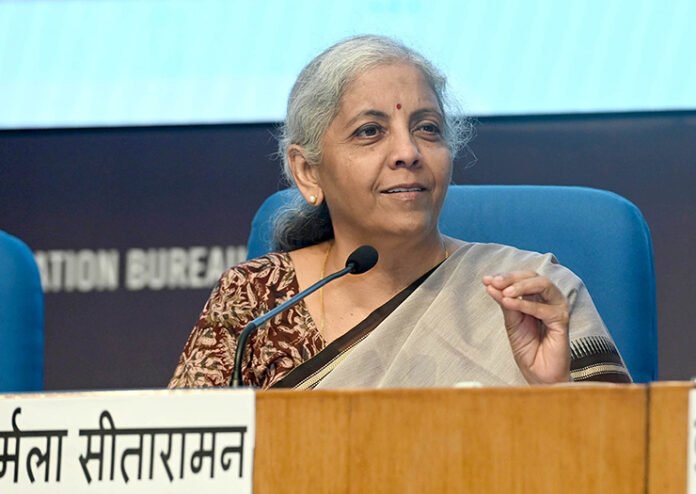In the Union Budget for the financial year 2024-25, presented on July 23, Finance Minister Nirmala Sitharaman has maintained the defence outlay nearly in line with the interim budget announced in February 2024, with a notable addition. This year’s budget includes an additional allocation of Rs 400 crore for the ‘Acing Development of Innovative Technologies with iDEX (ADITI)’ scheme. This scheme is intended to foster innovation by engaging with start-ups, micro, small, and medium enterprises (MSMEs), and other innovators to develop defence technology solutions. However, it remains unclear whether ADITI represents a rebranding of the Innovation for Defence Excellence (iDEX) scheme, which was introduced in 2018, or if it is a preliminary step towards establishing the Rs 1 lakh crore corpus for Deep-Tech announced during the interim budget.
The total allocation for the defence budget in FY2024-25 stands at Rs 6,21,940.85 crore, making it the largest allocation among all central government ministries. This allocation represents 12.9% of the central government’s total expenditure and 1.9% of the Gross Domestic Product (GDP). Compared to the previous year’s budget, this allocation reflects a growth of 4.79%. The defence budget has traditionally held the largest share of the central government’s expenditure, and this trend continues with the current year’s figures.
A significant portion of the defence budget, amounting to Rs 2,82,647.92 crore or 45.47%, is dedicated to revenue expenditure. This expenditure category includes various costs such as salaries, which constitute 30.66% of the revenue budget. The remaining revenue budget covers essential aspects like ration, clothing, operational expenditure on military stores, transportation, maintenance works, and repairs and refit of naval vessels. The Ministry of Defence (MoD) has allocated Rs 92,088 crore for sustenance and operational expenditure, reflecting a substantial increase of 48% from the FY 2022-23 figures. A comparative analysis with the previous year’s allocation would offer a more nuanced view of budgetary changes and the effectiveness of this increase.
Despite a substantial allocation of Rs 6,21,940.85 crore, India’s defence budget continues to face significant shortfalls relative to the armed forces’ requirements. The budget includes notable increases in pensions and domestic procurement but highlights ongoing challenges in aligning allocations with strategic needs and addressing the growing gap compared to global military expenditures
Capital Expenditure and Domestic Procurement
The capital expenditure for the defence services in FY2024-25 is set at Rs 1,72,000 crore, which represents 27.66% of the total defence budget. This figure is a 5.78% increase over the previous year’s allocation. Of this capital expenditure, Rs 1,05,518.43 crore (75%) is earmarked for procurement through domestic industries. The MoD’s press release highlights that this focus on domestic procurement is intended to stimulate economic growth by contributing to GDP, generating employment, and fostering capital formation. This policy aligns with the broader strategic objective of boosting the domestic defence manufacturing sector and reducing dependence on foreign suppliers.
Pensions and Research & Development
The allocation for defence pensions in the FY2024-25 budget is Rs 1,41,205 crore, accounting for 22.7% of the total defence budget. This allocation signifies a rapid increase from Rs 12,000 crore in FY 2000-01, which accounted for 16.91% of the defence budget. The rising pension burden reflects the increasing number of retired personnel and the growing financial commitments associated with their pensions.
The Defence Research and Development Organisation (DRDO), which is the primary agency responsible for defence research and development, has been allocated Rs 23,855 crore. This allocation is a marginal increase of Rs 591.11 crore from the previous year’s budget. Of this amount, more than half is allocated for capital expenditure. Despite this increase, the modest annual growth in the DRDO budget raises concerns about the pace and scale of advancements in defence technology. The DRDO’s role in developing new technologies and innovations is crucial for maintaining the armed forces’ operational edge, and the limited growth in its budget could potentially hinder progress in this area.

Border Roads Organisation and Indian Coast Guard Enhancements
The Border Roads Organisation (BRO) has received an allocation of Rs 6,500 crore for infrastructure development along the borders, representing a significant 30% increase from the previous year’s allocation. This funding is aimed at improving road infrastructure in strategically sensitive areas, which is vital for national security and efficient logistical support for the armed forces.
The Indian Coast Guard (ICG) has been allocated Rs 7,651.80 crore, an increase of Rs 454.33 crore from the previous year. Notably, more than 45% of this budget, amounting to Rs 3,500 crore, is designated for capital expenditure. This allocation indicates a strategic emphasis on enhancing maritime security capabilities, including acquiring high-speed patrol vessels, advanced electronic surveillance systems, and modern weapons. The ICG’s role in safeguarding India’s extensive coastline and maritime interests is crucial, and the increased budget reflects the need to address growing security challenges and provide humanitarian assistance.
The FY2024-25 defence budget reflects a 4.79% increase over the previous year. Notwithstanding these allocations, the overall budget continues to grapple with inadequacies, emphasising the need for effective financial planning and alignment with the armed forces’ extensive requirements
Budgetary Shortfalls and Strategic Concerns
Despite the substantial allocations, the Indian defence budget continues to fall short in comparison to China’s military expenditure, which is the second highest in the world after that of the United States. This disparity is significant given the comparable security challenges faced by both countries. India’s defence budget has consistently struggled to meet the requirements projected by the armed forces. The shortfall has ranged from Rs 23,014 crore in 2010-11 to Rs 1,01,678 crore in 2022-23, before dramatically reducing to Rs 32,214 crore in 2023-24. This reduction was attributed to the armed forces scaling down their projected requirements for capital expenditure.
The persistent gap between the budgetary allocations and the requirements projected by the armed forces highlights an ongoing issue in defence planning. For example, the requirement of Rs 26.84 lakh crore for the five-year period 2017-22, excluding pensions and funding for other organisations such as the BRO, ICG, and DRDO, was deemed unrealistic. Similarly, the fifteenth Finance Commission’s report revealed that the armed forces’ requirement for revenue and capital expenditure for the five-year period 2021-26 exceeded the estimated allocation by Rs 15,24,100 crore, based on assumptions of a 7% annual growth in revenue and 16% in capital expenditure.
Takeaways
The defence budget for FY2024-25 reflects both continuity and incremental change, with the additional allocation for the ADITI scheme highlighting a focus on innovation. However, the overall budgetary allocation, while substantial, continues to face challenges in addressing the growing needs of the armed forces. The persistent shortfalls and the difficulty in reconciling the budget with the armed forces’ projected requirements underscore the need for a more effective approach to defence planning, financial management, and a commitment to aligning defence needs with available resources.
The lack of attention to effective defence planning and budgeting has been a recurring issue, and finding a meeting ground between the armed forces’ requirements and available funds is essential for ensuring national security and operational readiness.
–The writer is a former Financial Advisor (Acquisition), Ministry of Defence. The views expressed are personal and do not necessarily reflect the views of Raksha Anirveda
–The writer is a former Financial Advisor (Acquisition), Ministry of Defence. The views expressed are personal and do not necessarily reflect the views of Raksha Anirveda






